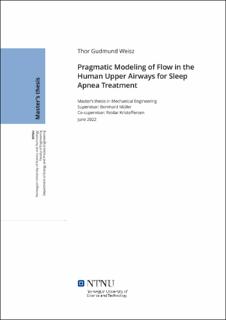| dc.contributor.advisor | Müller, Bernhard | |
| dc.contributor.advisor | Kristoffersen, Reidar | |
| dc.contributor.author | Weisz, Thor Gudmund | |
| dc.date.accessioned | 2022-10-01T17:25:27Z | |
| dc.date.available | 2022-10-01T17:25:27Z | |
| dc.date.issued | 2022 | |
| dc.identifier | no.ntnu:inspera:112775046:37630893 | |
| dc.identifier.uri | https://hdl.handle.net/11250/3023111 | |
| dc.description.abstract | A pragmatic model has been developed to provide rapid flow predictions on a patient-specific basis to gain insight into the state of a patient's airways. These flow predictions are aimed to be further used to predict the outcome of obstructive sleep apnea (OSA) surgery and provide the basis for a patient-specific system to be used by medical doctors. The pragmatic model transforms the human upper airways into a piping system by applying the hydraulic diameter equation to cross-sections extracted from 3D geometries created based on patient-specific computed tomography (CT) images. In this thesis, the pragmatic model has been expanded to include a system for creating the patient-specific 3D models, which provide the input for the pragmatic flow simulations. CFD simulations of a simplified version of the nasal cavity were performed to assess the use of the hydraulic diameter on the complex cross-sections in this region. The test cases implied that the standard hydraulic diameter was not entirely accurate in the nasal cavity by performing both CFD and pragmatic simulations. Therefore a novel approach that involved substituting the constant 4 in the hydraulic diameter equation with a variable coefficient, C_Dh, termed the hydraulic diameter coefficient, was proposed. The results from the validation case showed that C_Dh = 3.71 gave more accurate results when applied to the pragmatic simulations for the test cases. Negligible improvements were found when applying the new coefficient to the pragmatic simulations for the upper airways of an OSA patient. The hydraulic diameter coefficient was further decreased to obtain the coefficient which gave the best results. C_Dh = 1.80 gave the best agreement with the verification data available. Pressure-recovery coefficients have been implemented in the pragmatic model to adjust for unphysical pressure increases seen in sections with expanding geometries in the previous model iteration. The implementation of pressure-recovery coefficients in these sections, using an optimization approach, gave excellent agreement with the verification data. Applying the obtained coefficients to the same patient's post-operative geometry gave a similarly good result. Patient-specific pragmatic simulations for two other patients have been performed by applying the same simulation settings for the hydraulic diameter and the pressure-recovery coefficients. However, results from these simulations proved to be inconclusive. In conclusion, notable improvements to the pragmatic model have been made by adjusting the proposed hydraulic diameter coefficient and for unphysical pressure recovery by applying pressure-recovery coefficients. | |
| dc.description.abstract | En pragmatisk modell for å gi pasientspesifikke strømningsprediksjoner har tidligere blitt utviklet for raskt kunne gi få innsikt i tilstanden til pasienters luftveier. Disse strømningsprediksjonene skal videre brukes til å forutsi utfallet av obstruktiv søvnapné-kirurgi og gi grunnlaget for et pasientspesifikt system som skal brukes av leger. Modellen gjør om menneskets øvre luftveier til et rørsystem ved å bruke den hydrauliske diameterligningen på tverrsnitt tatt fra 3D-geometrier laget basert på pasientspesifikke CT- bilder. I denne oppgaven har den pragmatiske modellen utvidet for å inkludere et system for å lage de pasientspesifikke 3D-modellene, som er grunnlaget de pragmatiske strømningssimuleringene. CFD-simuleringer av en forenklet versjon av nesehulen har blitt utført for å vurdere bruken av den hydrauliske diameteren på de komplekse tverrsnittene i denne regionen. Testtilfellene antydet at den konvensjonelle hydrauliske diameteren ikke var helt nøyaktig i nesehulen ved å utføre både CFD og pragmatiske simuleringer. Derfor ble det foreslått en ny tilnærming som innebar å erstatte konstanten 4 med en variabel koeffisient, C_Dh, kalt den hydrauliske diameterkoeffisienten. Resultatene fra valideringen viste at C_Dh = 3.71 ga mer nøyaktige resultater når de ble brukt på de pragmatiske simuleringene for testtilfellene. Ubetydelige forbedringer ble funnet når den nye koeffisienten ble brukt på de pragmatiske simuleringene for de øvre luftveiene til en søvnapné -pasient. Den hydrauliske diameterkoeffisienten ble ytterligere redusert for å oppnå en koeffisient med best mulig resultater. C_Dh = 1,80 ga best samsvar med tilgjengelige bekreftelsesdata. Trykkgjenvinningskoeffisienter ble videre implementert i den pragmatiske modellen for å justere for de ufysisikalske trykkøkningene observert i seksjoner med ekspanderende geometrier i forrige iterasjon av den pragmatiske modellen. Implementeringen av trykk-gjenopprettingskoeffisienter i disse seksjonene, ved bruk av en optimaliseringstilnærming, ga utmerket samsvar med verifikasjonsdataene. Bruk av de oppnådde koeffisientene på samme pasients postoperative geometri ga et tilsvarende godt resultat. Pasientspesifikke pragmatiske simuleringer for to andre pasienter er utført ved å bruke de samme simuleringsinnstillingene for den hydrauliske diameteren og trykkgjenvinningskoeffisienten. Resultatene fra disse simuleringene viste seg imidlertid å være usikre. Avslutningsvis har bemerkelsesverdige forbedringer av den pragmatiske modellen blitt gjort ved bruk av den foreslåtte hydrauliske diameterkoeffisienten, sammen med justering for den ufysikalske trykkgjenvinningen ved å bruke trykkgjenvinningskoeffisienter. | |
| dc.language | eng | |
| dc.publisher | NTNU | |
| dc.title | Pragmatic Modeling of Flow in the Human Upper Airways for Sleep Apnea Treatment | |
| dc.type | Master thesis | |
